How to Read the Shapiro Wilk Test
Testing for Normality using SPSS Statistics
Introduction
An assessment of the normality of information is a prerequisite for many statistical tests because normal data is an underlying assumption in parametric testing. There are two main methods of assessing normality: graphically and numerically.
This "quick commencement" guide will help yous to determine whether your information is normal, and therefore, that this supposition is met in your data for statistical tests. The approaches can be divided into two main themes: relying on statistical tests or visual inspection. Statistical tests accept the reward of making an objective judgement of normality, just are disadvantaged by sometimes not being sensitive enough at low sample sizes or overly sensitive to large sample sizes. Equally such, some statisticians prefer to utilise their experience to make a subjective sentence nearly the data from plots/graphs. Graphical interpretation has the advantage of allowing practiced judgement to assess normality in situations when numerical tests might exist over or under sensitive, but graphical methods do lack objectivity. If yous exercise not take a great bargain of experience interpreting normality graphically, information technology is probably all-time to rely on the numerical methods.
If you lot want to exist guided through the testing for normality process in SPSS Statistics for the specific statistical test you lot are using to analyse your data, nosotros provide comprehensive guides in our enhanced content. For each statistical test where you lot need to examination for normality, we show y'all, step-by-pace, the procedure in SPSS Statistics, too as how to bargain with situations where your data fails the assumption of normality (e.g., where you can endeavour to "transform" your data to make it "normal"; something we besides prove you how to do using SPSS Statistics). Yous can larn about our enhanced content in full general on our Features: Overview page or how we aid with assumptions on our Features: Assumptions page. However, in this "quick beginning" guide, nosotros take you through the basics of testing for normality in SPSS Statistics.
SPSS Statistics
Methods of assessing normality
SPSS Statistics allows y'all to examination all of these procedures inside Explore... control. The Explore... command tin be used in isolation if you are testing normality in one grouping or splitting your dataset into i or more groups. For example, if you accept a group of participants and you demand to know if their height is normally distributed, everything tin exist done within the Explore... command. If you lot split your group into males and females (i.e., you have a categorical independent variable), you can exam for normality of meridian within both the male grouping and the female grouping using just the Explore... command. This applies even if you have more than two groups. However, if yous have 2 or more categorical, contained variables, the Explore... control on its own is not plenty and yous will have to use the Split File... command as well.
Note: The procedures that follow are identical for SPSS Statistics versions 17 to 28, also as the subscription version of SPSS Statistics, with version 28 and the subscription version beingness the latest versions of SPSS Statistics. Withal, in version 27 and the subscription version, SPSS Statistics introduced a new look to their interface called "SPSS Light", replacing the previous look for versions 26 and earlier versions, which was chosen "SPSS Standard". Therefore, if you take SPSS Statistics versions 27 or 28 (or the subscription version of SPSS Statistics), the images that follow will be lite grey rather than blue. However, the procedures are identical.
SPSS Statistics
Process for none or one grouping variable
The following instance comes from our guide on how to perform a i-way ANOVA in SPSS Statistics.
- Click Analyze > Descriptive Statistics > Eastwardxplore... on the elevation menu, as shown below:
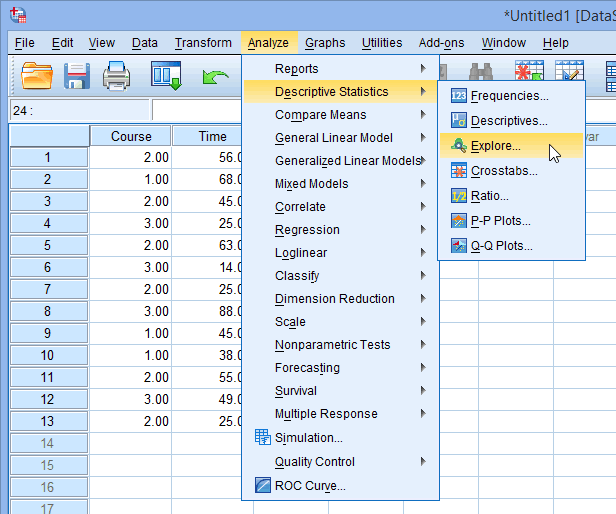
Published with written permission from SPSS Statistics, IBM Corporation.
- You will exist presented with the Explore dialogue box, equally shown below:
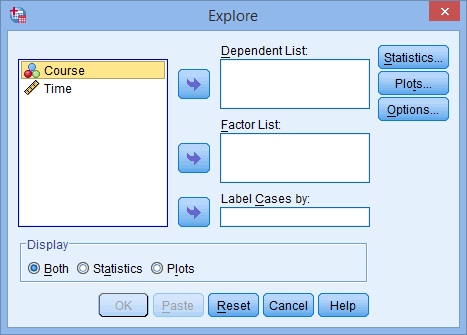
Published with written permission from SPSS Statistics, IBM Corporation.
- Transfer the variable that needs to exist tested for normality into the Dependent List: box by either drag-and-dropping or using the
![SPSS Arrow Right Button SPSS Arrow Right Button]() button. In this case, we transfer the Time variable into the Dependent Listing: box. You volition then exist presented with the post-obit screen:
button. In this case, we transfer the Time variable into the Dependent Listing: box. You volition then exist presented with the post-obit screen: 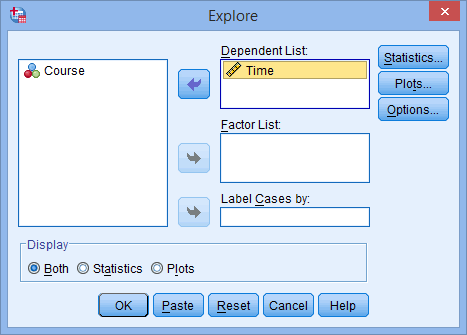
Published with written permission from SPSS Statistics, IBM Corporation.
- [Optional] If you need to found if your variable is unremarkably distributed for each level of your contained variable, you lot need to add your contained variable to the Factor Listing: box past either elevate-and-dropping or using the
![SPSS Arrow Right Button SPSS Arrow Right Button]() push. In this instance, we transfer the Course variable into the Fplayer List: box. You will be presented with the following screen:
push. In this instance, we transfer the Course variable into the Fplayer List: box. You will be presented with the following screen: 
Published with written permission from SPSS Statistics, IBM Corporation.
- Click on the
![SPSS Statistics Button SPSS Statistics Button]() push button. You will be presented with the Explore: Statistics dialogue box, as shown below:
push button. You will be presented with the Explore: Statistics dialogue box, as shown below: 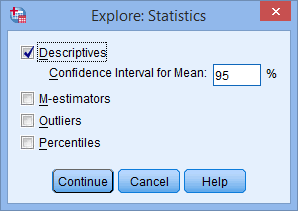
Published with written permission from SPSS Statistics, IBM Corporation.
Leave the above options unchanged and click on the
![SPSS Continue Button SPSS Continue Button]() button.
button. - Click on the
![SPSS Plots Button SPSS Plots Button]() button. Change the options so that you are presented with the following screen:
button. Change the options so that you are presented with the following screen: 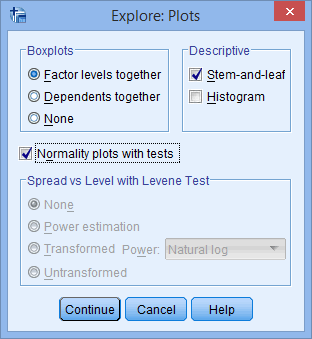
Published with written permission from SPSS Statistics, IBM Corporation.
- Click on the
![Continue]() button.
button. - Click on the
![OK]() button.
button.
SPSS Statistics
Output
SPSS Statistics outputs many tabular array and graphs with this process. I of the reasons for this is that the Explore... command is not used solely for the testing of normality, but in describing data in many different ways. When testing for normality, nosotros are mainly interested in the Tests of Normality tabular array and the Normal Q-Q Plots, our numerical and graphical methods to examination for the normality of information, respectively.
Shapiro-Wilk Test of Normality

Published with written permission from SPSS Statistics, IBM Corporation.
The above table presents the results from ii well-known tests of normality, namely the Kolmogorov-Smirnov Examination and the Shapiro-Wilk Test. The Shapiro-Wilk Test is more appropriate for pocket-sized sample sizes (< 50 samples), but can too handle sample sizes as large every bit 2000. For this reason, nosotros volition apply the Shapiro-Wilk test as our numerical means of assessing normality.
We tin can come across from the above table that for the "Beginner", "Intermediate" and "Advanced" Course Group the dependent variable, "Time", was normally distributed. How do we know this? If the Sig. value of the Shapiro-Wilk Test is greater than 0.05, the information is normal. If information technology is beneath 0.05, the information significantly deviate from a normal distribution.
If you need to use skewness and kurtosis values to decide normality, rather the Shapiro-Wilk test, you lot will notice these in our enhanced testing for normality guide. You can larn more than about our enhanced content on our Features: Overview page.
Normal Q-Q Plot
In social club to determine normality graphically, nosotros can apply the output of a normal Q-Q Plot. If the data are normally distributed, the information points volition be close to the diagonal line. If the data points devious from the line in an obvious non-linear way, the data are not commonly distributed. Every bit we tin can encounter from the normal Q-Q plot beneath, the data is normally distributed. If you are at all unsure of being able to correctly translate the graph, rely on the numerical methods instead considering it tin take a off-white bit of feel to correctly judge the normality of data based on plots.

Published with written permission from SPSS Statistics, IBM Corporation.
If you need to know what Normal Q-Q Plots look similar when distributions are non normal (e.g., negatively skewed), you will observe these in our enhanced testing for normality guide. You lot can larn more about our enhanced content on our Features: Overview page.
wojtowiczthouggerve.blogspot.com
Source: https://statistics.laerd.com/spss-tutorials/testing-for-normality-using-spss-statistics.php






0 Response to "How to Read the Shapiro Wilk Test"
Post a Comment